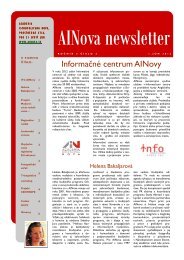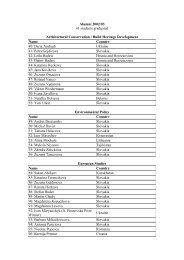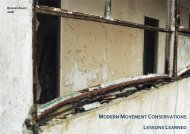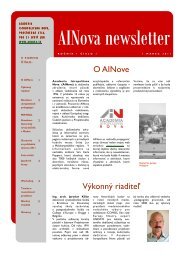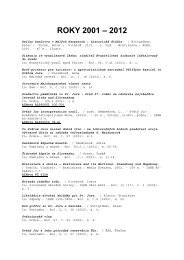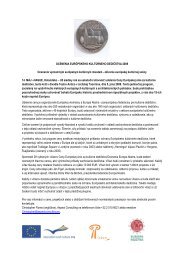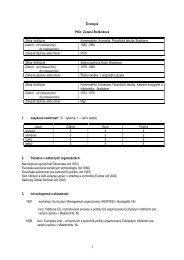The Argument about the Cultural Heritage Value and its Assessment ...
The Argument about the Cultural Heritage Value and its Assessment ...
The Argument about the Cultural Heritage Value and its Assessment ...
You also want an ePaper? Increase the reach of your titles
YUMPU automatically turns print PDFs into web optimized ePapers that Google loves.
<strong>Heritage</strong> List has been commenced, shall also be considered as a cultural heritage. In order<br />
to determine <strong>the</strong> duration of <strong>the</strong> legal protection of <strong>the</strong> objects, potential monuments, it is<br />
necessary to answer <strong>the</strong> question when <strong>the</strong> administrative procedure begins. It is not so clear<br />
from <strong>the</strong> wording of §15 of <strong>the</strong> Monuments Act: Ministry of Culture shall declare a movable<br />
or immovable object of cultural heritage value as a cultural monument on a proposal from<br />
central Monuments Board. <strong>The</strong> owner of <strong>the</strong> object is a party to <strong>the</strong> administrative procedure<br />
<strong>and</strong> has a right to submit his observations (§ 15 section 3). <strong>The</strong>refore it has to be inferred that<br />
<strong>the</strong> procedure starts upon <strong>the</strong> notification of <strong>the</strong> procedure to <strong>the</strong> owner. Such a notification<br />
creates legal effect for <strong>the</strong> owner by imposing st<strong>and</strong>still obligation – <strong>the</strong> owner is obliged i) to<br />
abstain from any action which would damage <strong>the</strong> object <strong>and</strong>, ii) to enable state officials to<br />
conduct <strong>the</strong> historical, architectural <strong>and</strong> o<strong>the</strong>r survey of <strong>the</strong> building for <strong>the</strong> purpose of <strong>the</strong><br />
procedure. <strong>The</strong> procedure is brought to an end when <strong>the</strong> final decision against which <strong>the</strong>re is<br />
no appeal, has become res iudicata - entered into force. <strong>The</strong> final decision confirms<br />
inscription or rejects it (§ 15 section 5).<br />
Is <strong>the</strong> nature of <strong>the</strong> decision making purely legal <strong>and</strong> technocratic<br />
Pursuant to <strong>the</strong> old version of <strong>the</strong> Monuments Act applicable until 1 st of June 2009 (to<br />
<strong>the</strong> facts of <strong>the</strong> Gumon case) <strong>the</strong> first instance authority taking <strong>the</strong> decision on <strong>the</strong> application<br />
for inscription of <strong>the</strong> monument has been vested with <strong>the</strong> Ministry of Culture. <strong>The</strong> application<br />
for inscription has been elaborated <strong>and</strong> submitted by <strong>the</strong> central Monuments Board<br />
(Monuments Board of Slovak Republic). <strong>The</strong> owner as a party to <strong>the</strong> procedure had <strong>the</strong> right<br />
to file special legal appeal against <strong>the</strong> decision of <strong>the</strong> Ministry (“rozklad”), which would be<br />
reviewed by <strong>the</strong> Minister of Culture consulting special committee (“rozkladová komisia”)<br />
whose opinion is not binding on Minister. Thus <strong>the</strong> nature of <strong>the</strong> decision-making had been<br />
political <strong>and</strong> precisely for this reason <strong>the</strong> real purpose behind § 2 section 1 second sentence to<br />
prevent demolition of objects before <strong>the</strong> completion of administrative procedure has been<br />
negated.<br />
<strong>The</strong> amendment of <strong>the</strong> Monuments Act n. 208/2009 Coll. applicable since 1st of June<br />
2009 attempts to resolve this problem by transferring <strong>the</strong> administrative procedure from <strong>the</strong><br />
political ministerial level to <strong>the</strong> specialized technocratic level of central Monuments Board,<br />
where it really should have been from <strong>the</strong> moment <strong>the</strong> Monuments Act entered into force (1 st<br />
April 2002). Nowadays <strong>the</strong> application for inscription is submitted by <strong>the</strong> regional<br />
5





